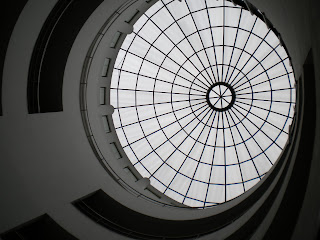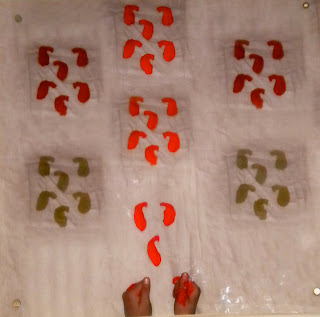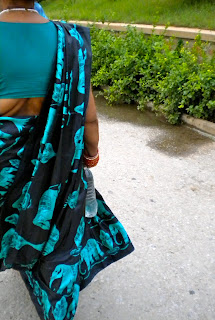This is Kinetic Seqencing. As you can see, the door frame is rotated in different directions and appears to the eye as a moving frame. This picture was taken in our day in Jaipur at the palace after the elephant ride.

Tension: The crack you see here represents tension, the squeezing out of positive, country side view from the dark, hard side of a brick. This was taken at MICA in ahmedabad.

Proportion: This is a great shot from the top of the palace in Jaipur. The proportion is of the man's height to the negative space of the road around him, and of the buildings that lay before him. As you can see, his nature is very small compared to the environment around him.

Rhythm: This architecture represents rhythm because of the nature of the framing arches and the repetition of the shapes. The photograph was taken at the palace in Jaipur.

Repetition: I love the elephants of India and this picture is a great representation of the wonders of old Indian detailing. These elephants and people are on the sun temple, two hours away from Ahmedabad. The picture is detailed, yet the motion of the elephant heads is distinct.

Mass 1: This photo is of the marble temple. It just screams mass. Notice the weight on top of the pillars. I especially enjoy the contrast of the white marble to the dark space in the middle of the photo.

Mass 2: THE TAJ MAHAL. This is a photo of the Taj Mahal in Agra, India. The structure and the archways, along with the tiny pillars all contribute to its on-looking, forceful mass.

Point of view: This is a picture I took in Delhi. It's at the sight of the oldest non-rusting iron pillar and its over 900 years old. The detailing on this pillar is in Arabic.

Contrast: This is a photo taken in Old Ahmedabad. The contrast element is within the colors of the photo. The whites against the blacks along with the dark skin of the man makes it a concrete example of white v. black.

Unity: This is a tree on the streets of Mumbai. The branches were intertwined with one another, making this massive tree! The branches are unified into one structure, the tree.

Scale: This photo was taken at the sight of the first temple we saw in old town Ahmedabad. This door is tiny! I couldn't even walk through it and I'm 5'6". But this lady gives the image a compliment to the size of the door. The concrete block projects massive and structure.

Asymmetrical: This was a shot taken in Jaipur. The concrete, white structure is all symmetric. The lady makes this shot complete.

Symmetry

Proximity

Alignment

Gestalt

Eyeflow

Eyeflow: The monkey's tail is not the branch

Hierarchy of Monkeys

Grid System

Figure Ground

Negative Space

 This was one of my favorite days on the trip. This is a picture of the sky above the Taj Mahal in Agra, Agra. The clouds were endless that day and the sky was this perfect blue color. It made for a pretty cool texture picture. They definitely look fluffy.
This was one of my favorite days on the trip. This is a picture of the sky above the Taj Mahal in Agra, Agra. The clouds were endless that day and the sky was this perfect blue color. It made for a pretty cool texture picture. They definitely look fluffy. This is a picture of our elephant's trunk, Balboa. We rode elephants in Jaipur, India. The elephant ride was like riding in a rocky boat, but without the waves and seasickness. Anyways, this trunk is a texture has the roughest skin, but the most beautiful trunk.
This is a picture of our elephant's trunk, Balboa. We rode elephants in Jaipur, India. The elephant ride was like riding in a rocky boat, but without the waves and seasickness. Anyways, this trunk is a texture has the roughest skin, but the most beautiful trunk. This is a picture in Ahmedabad at the well. The first sight seeing day we did as a whole SMU group was the 4th of July. This was the 2nd stop on our adventure and the well was a pretty cool structure to see. This texture is full of Indian symbols and prestigious Indian animals.
This is a picture in Ahmedabad at the well. The first sight seeing day we did as a whole SMU group was the 4th of July. This was the 2nd stop on our adventure and the well was a pretty cool structure to see. This texture is full of Indian symbols and prestigious Indian animals. This door was at the first Temple we went to as an Undergraduate group in our first outing to Downtown Ahmedabad. The rough structure reminds me of a prison or tourturing chamber. But in fact, this was a door next to one of the temples!
This door was at the first Temple we went to as an Undergraduate group in our first outing to Downtown Ahmedabad. The rough structure reminds me of a prison or tourturing chamber. But in fact, this was a door next to one of the temples!














































